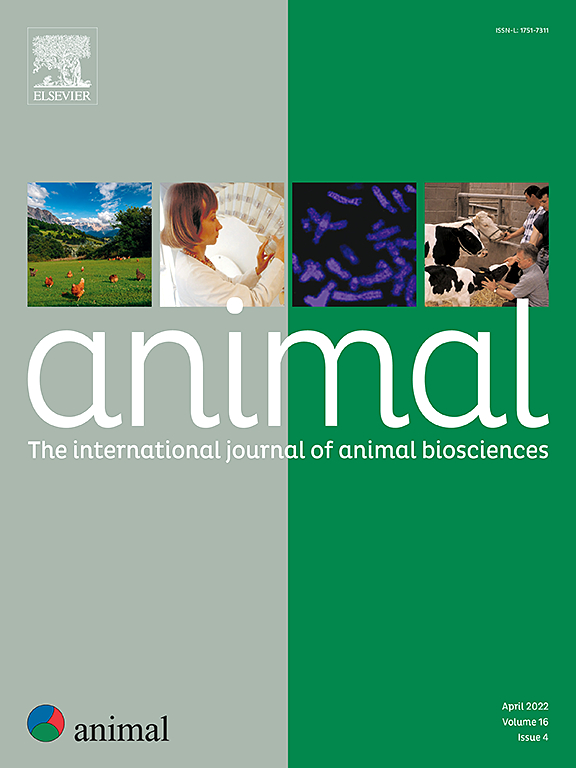Does the use of Beef-on-Dairy lead to increased longevity in dairy herds?
IF 4.2
2区 农林科学
Q1 AGRICULTURE, DAIRY & ANIMAL SCIENCE
引用次数: 0
Abstract
The genetic progress of longevity in Holsteins has been very strong over the last years; however, the phenotypic longevity only increases moderately. It is often argued that this discrepancy between genetic and phenotypic longevity can mainly be explained with the availability of too many replacement heifers on the farms. Following this hypothesis, a farmer would rather prematurely cull a cow from the herd than the freshly calved heifer. The availability of dairy replacements on the other side depends on other management decisions: rate of born female dairy calves, rate of losses, sales and purchases of female dairy calves. The rate of born female dairy calves is influenced largely by (a) the use of sexed semen and (b) the use of beef semen on dairy cows (BoD). In our study, we analysed, whether herds with a lower rate of born female dairy calves (and therefore less available replacement heifers) have higher average longevity of cows. The data set comprised 2 784 880 calving records and 1 025 203 disposals, resulting in data of 10 627 German herds. These herds were clustered into groups based on (1) the proportion of BoD use and (2) the proportion of female dairy calves born in 2020/2021. The average longevity of cows culled in 2022/2023 (replaced by calves born in 2020/2021) was compared. The genetic level (Estimated breeding value of longevity) did not differ significantly between the categories of farms nor did the average production level (milk yield) per herd. A significant association was found between BoD use and phenotypic longevity: herds with high BoD use (> 20%) had an average longevity that was 147 days longer than that of herds with no BoD use (< 2%). Similarly, herds with a lower proportion of female dairy calves born had a significantly higher average longevity: herds with > 55% female dairy calves (thus, a high number of possible replacement heifers) had an average longevity of 1 197 days, whereas herds with < 40% female dairy calves had an average longevity of 1 335 days. This strong increase in average longevity related to the reduction of possible replacements indicates that many cows are culled early due to management decisions rather than due to health issues and other functional reasons.
使用牛乳加牛肉会增加奶牛群的寿命吗?
在过去的几年里,荷斯泰因人长寿的基因进展非常强劲;然而,表型寿命仅适度增加。人们经常认为,遗传寿命和表型寿命之间的差异主要可以用农场上有太多替代小牛的可用性来解释。根据这一假设,农民宁愿过早地从牛群中剔除一头母牛,也不愿从刚出生的小母牛中剔除一头。另一方面,乳制品替代品的可用性取决于其他管理决策:雌性奶牛的出生率、损失率、雌性奶牛的销售和购买。奶牛出生雌犊的比率在很大程度上受(a)使用性别精液和(b)奶牛使用牛肉精液(BoD)的影响。在我们的研究中,我们分析了出生雌性小牛率较低(因此可用的替代小牛较少)的牛群是否具有较高的奶牛平均寿命。该数据集包括2 784 880个产犊记录和1 025 203个处理记录,产生10 627个德国畜群的数据。根据(1)生物需氧量使用比例和(2)2020/2021年出生的母奶牛比例将这些牛群聚类。比较了2022/2023年淘汰的奶牛(由2020/2021年出生的小牛取代)的平均寿命。遗传水平(估计的长寿育种价值)在农场类别之间没有显著差异,每群平均生产水平(产奶量)也没有显著差异。需氧量的使用与表型寿命之间存在显著关联:需氧量高的畜群(>;20%)的平均寿命比不使用BoD的畜群(<;2%)。同样,出生的母牛犊比例较低的牛群平均寿命明显较高。55%的雌性奶牛(因此,可能替代的小母牛数量很高)的平均寿命为1197天,而与<;40%的母犊牛平均寿命为1335天。平均寿命的大幅增加与可能替代的减少有关,这表明许多奶牛是由于管理决策而不是由于健康问题和其他功能原因而被提前淘汰的。
本文章由计算机程序翻译,如有差异,请以英文原文为准。
求助全文
约1分钟内获得全文
求助全文
来源期刊

Animal
农林科学-奶制品与动物科学
CiteScore
7.50
自引率
2.80%
发文量
246
审稿时长
3 months
期刊介绍:
Editorial board
animal attracts the best research in animal biology and animal systems from across the spectrum of the agricultural, biomedical, and environmental sciences. It is the central element in an exciting collaboration between the British Society of Animal Science (BSAS), Institut National de la Recherche Agronomique (INRA) and the European Federation of Animal Science (EAAP) and represents a merging of three scientific journals: Animal Science; Animal Research; Reproduction, Nutrition, Development. animal publishes original cutting-edge research, ''hot'' topics and horizon-scanning reviews on animal-related aspects of the life sciences at the molecular, cellular, organ, whole animal and production system levels. The main subject areas include: breeding and genetics; nutrition; physiology and functional biology of systems; behaviour, health and welfare; farming systems, environmental impact and climate change; product quality, human health and well-being. Animal models and papers dealing with the integration of research between these topics and their impact on the environment and people are particularly welcome.
 求助内容:
求助内容: 应助结果提醒方式:
应助结果提醒方式:


